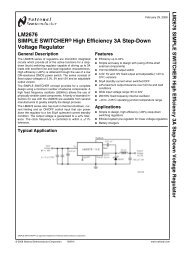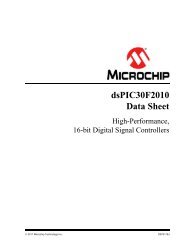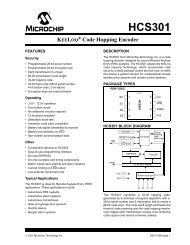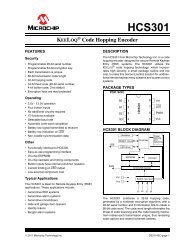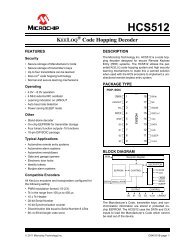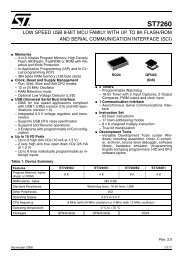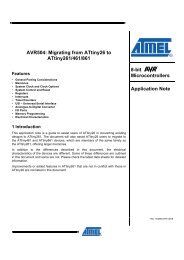You also want an ePaper? Increase the reach of your titles
YUMPU automatically turns print PDFs into web optimized ePapers that Google loves.
<strong>STM32W108C8</strong><br />
Interrupts<br />
Table 122.<br />
NVIC exception table (continued)<br />
Exception Position Description<br />
IRQD 31 IRQD peripheral interrupt.<br />
Debug 32 Debug peripheral interrupt.<br />
The NVIC also contains a software-configurable interrupt prioritization mechanism. The<br />
Reset, NMI, and Hard Fault exceptions, in that order, are always the highest priority, and are<br />
not software-configurable. All other exceptions can be assigned a 5-bit priority number, with<br />
low values representing higher priority. If any exceptions have the same softwareconfigurable<br />
priority, then the NVIC uses the hardware-defined priority. The hardwaredefined<br />
priority number is the same as the position of the exception in the exception table.<br />
For example, if IRQA and IRQB both fire at the same time and have the same softwaredefined<br />
priority, the NVIC handles IRQA, with priority number 28, first because it has a<br />
higher hardware priority than IRQB with priority number 29.<br />
The top level interrupts are controlled through five ARM® Cortex-M3 NVIC registers:<br />
INT_CFGSET, INT_CFGCLR, INT_PENDSET, INT_PENDCLR, and INT_ACTIVE. Writing 0<br />
into any bit in any of these five register is ineffectual.<br />
● INT_CFGSET - Writing 1 to a bit in INT_CFGSET enables that top level interrupt.<br />
●<br />
●<br />
●<br />
INT_CFGCLR - Writing 1 to a bit in INT_CFGCLR disables that top level interrupt.<br />
INT_PENDSET - Writing 1 to a bit in INT_PENDSET triggers that top level interrupt.<br />
INT_PENDCLR - Writing 1 to a bit in INT_PENDCLR clear that top level interrupt.<br />
● INT_ACTIVE cannot be written to and is used for indicating which interrupts are<br />
currently active.<br />
INT_PENDSET and INT_PENDCLR set and clear a simple latch; INT_CFGSET and<br />
INT_CFGCLR set and clear a mask on the output of the latch. Interrupts may be pended<br />
and cleared at any time, but any pended interrupt will not be taken unless the corresponding<br />
mask (INT_CFGSET) is set, which allows that interrupt to propagate. If an INT_CFGSET bit<br />
is set and the corresponding INT_PENDSET bit is set, then the interrupt will propagate and<br />
be taken. If INT_CFGSET is set after INT_PENDSET is set, then the interrupt will also<br />
propagate and be taken. Interrupt flags (signals) from the top level interrupts are levelsensitive.<br />
The second-level interrupt registers, which provide control of the second-level Event<br />
Manager peripheral interrupts, are described in Section 12.2: Event manager.<br />
For further information on the NVIC and Cortex-M3 exceptions, refer to the ARM® Cortex-<br />
M3 Technical Reference Manual and the ARM ARMv7-M Architecture Reference Manual.<br />
12.1.1 Non-maskable interrupt (NMI)<br />
The non-maskable interrupt (NMI) is a special case. Despite being one of the 10 standard<br />
ARM® Cortex-M3 NVIC interrupts, it is sourced from the Event Manager like a peripheral<br />
interrupt. The NMI has two second-level sources; failure of the 24 MHz crystal and<br />
watchdog low water mark.<br />
1. Failure of the 24 MHz crystal: If the <strong>STM32W108C8</strong>'s main clock, SCLK, is operating<br />
from the 24 MHz crystal and the crystal fails, the <strong>STM32W108C8</strong> detects the failure<br />
and automatically switch to the internal 12 MHz RC clock. When this failure detection<br />
Doc ID 018587 Rev 2 176/215





